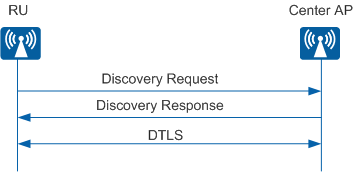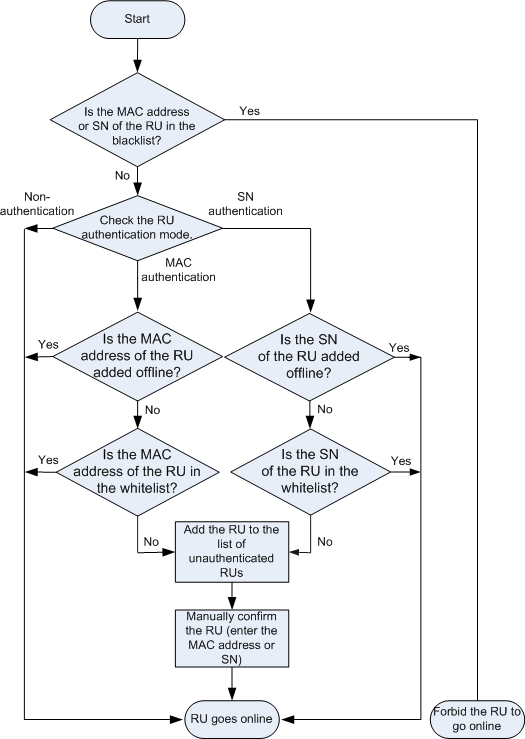RU Online Process
An agile distributed WLAN is composed of an AC, a central AP, and RUs. The AC centrally manages the central AP and RUs. The central AP and its connected RUs must be reachable at Layer 2. RUs are connected to a central AP, and receive and send 802.11 packets through the air interface. A central AP takes over some of an AC's work to perform central management and collaboration of RUs, such as STA going online, configuration delivery, and STA roaming between RUs. The central AP and RUs need to go online before being managed and controlled by the AC.
See AP Online Process for the online process of the central AP.
IP Address Allocation
CAPWAP packets between the central AP and RUs are forwarded at Layer 2 and are independent of IP addresses on an agile distributed WLAN. Therefore, the configuration of an IP address does not affect the RU going online. Ensure that a route is reachable between the IP address of the RU and the central AP source address. Otherwise, services involving IP addresses may be affected, for example, Telnet.
- Static mode: An IP address is manually configured for an RU.
- DHCP mode: An RU functions as a DHCP client and requests an IP address from a DHCP server.
CAPWAP Tunnel Establishment
- Maintain connectivity states between the AC and RUs.
- Help the AC to manage and deliver configurations to RUs.
- Transmit service data to the AC for centralized forwarding.
- See AP Online Process for the process of establishing a CAPWAP control tunnel between the AC and central AP.
- See Figure 1 for the process of establishing a CAPWAP control tunnel between the central AP and RU.
An RU sends a Discovery Request packet to find a central AP. (Discovery Phase) The central AP determines whether to allow the RU. This process is similar to that in RU access and control phase. For details, see Figure 2. The central AP does not respond to Discovery Request packets sent by the RU that is not allowed.
An RU can discover a central AP in either of the following two modes.When no IP address list of central APs is configured on an RU or an RU does not receive any Discovery Response packet after sending unicast Discovery Request packets ten consecutive times, the RU will broadcast Discovery Request packets to automatically discover a central AP in the same network segment and then selects a central AP to establish a CAPWAP tunnel according to the returned Discovery Response packets.
A static IP address list of central APs is preconfigured on an RU. When the RU goes online, it sends a unicast Discovery Request packet to each central AP whose IP address is specified in the IP address list. After receiving the Discovery Request packet, the central APs return Discovery Response packets to the RU. The RU then selects a central AP to establish a CAPWAP tunnel.
The RU establishes a CAPWAP tunnel with a central AP.
CAPWAP tunnels include data tunnels and control tunnels.- Data tunnel: transmits service data from the RU to an AC for centralized forwarding.
- Control tunnel: transmits control packets between the RU and central AP or between the RU and AC. You can choose to enable datagram transport layer security (DTLS) encryption over the control tunnel to ensure security of CAPWAP control packets. Subsequently, all CAPWAP control packets will be encrypted and decrypted through DTLS, ensuring integrity and privacy of the CAPWAP control packets.
CAPWAP Tunnel Maintenance
For the AD9430DN-12 and AD9430DN-24, the RU and central AP exchange Keepalive packets to detect the data tunnel connectivity. For the AD9431DN-24X, the RU and AC exchange Keepalive packets to detect the data tunnel connectivity.
The RU and central AP exchange Echo packets to detect the control tunnel connectivity.
RU Access Control
When an RU requests to access the AC, the central AP sends an Authentication Request packet to the AC. The AC then determines whether to allow the RU access and returns an Authentication Response packet to the AP. The Authentication Response packet carries the RU software upgrade mode and RU version.
Figure 2 shows a flowchart depicting the process for RU access control.
RU Software Upgrade
The RU determines whether its system software version is the same as that specified on the AC according to parameters in the received Authentication Response packet.
If so, the RU goes to the next stage.
If not, the RU upgrades its version in the upgrade mode carried in the Authentication Response packets. The upgrade mode includes the AC mode, FTP mode, and SFTP mode.
After the software version is updated, the RU restarts and repeats the preceding steps.

